If you’ve been out of the loop since Chat GPT was released at the end of November, here’s a quick overview. Chat GPT is a text-based AI tool that generates responses to user-entered prompts. It was designed to simulate human conversation and has been used in many ways like debugging code, copywriting, translating, summarising, creating chatbots and virtual assistants.

The AI was trained on billions of words, including news articles, books, and websites. This large dataset gives it the ability to create human-like responses with accuracy. However, it has limited knowledge of events after 2021 — which is when it was last ‘fed’ information.
It’s currently in a ‘Free Research Preview’, which allows its creators to improve its ability to answer questions and learn from feedback. Presumably, Chat GPT will be monetized at some point, similar to Open AI’s other programs, Playground and Dall•e 2.
How I use Chat GPT
I’ve been experimenting with Chat GPT since mid-December. My friend Jess (an excellent Product Lead) introduced it to me. I’ve had the AI create recipes from leftovers in my fridge, help me write challenging emails, rank the Fast and Furious movies, analyse data, and be my dyslexic sounding board. Most relevant to this blog post, it’s also been my LinkedIn content creator.
Chat GPT as a content creator
Literally the day after learning about Chat GPT I thought I’d run a little experiment: “What if I used Chat GPT to write my next few LinkedIn posts?”. Would people notice? Would it simplify posting? Would I get better analytics?
My first post started with a super generic prompt “Write a two-tweet thread about accessibility in UX design”. I decided to only post the second part of the generated tweet thread. After posting, it had 932 impressions and 22 reactions.
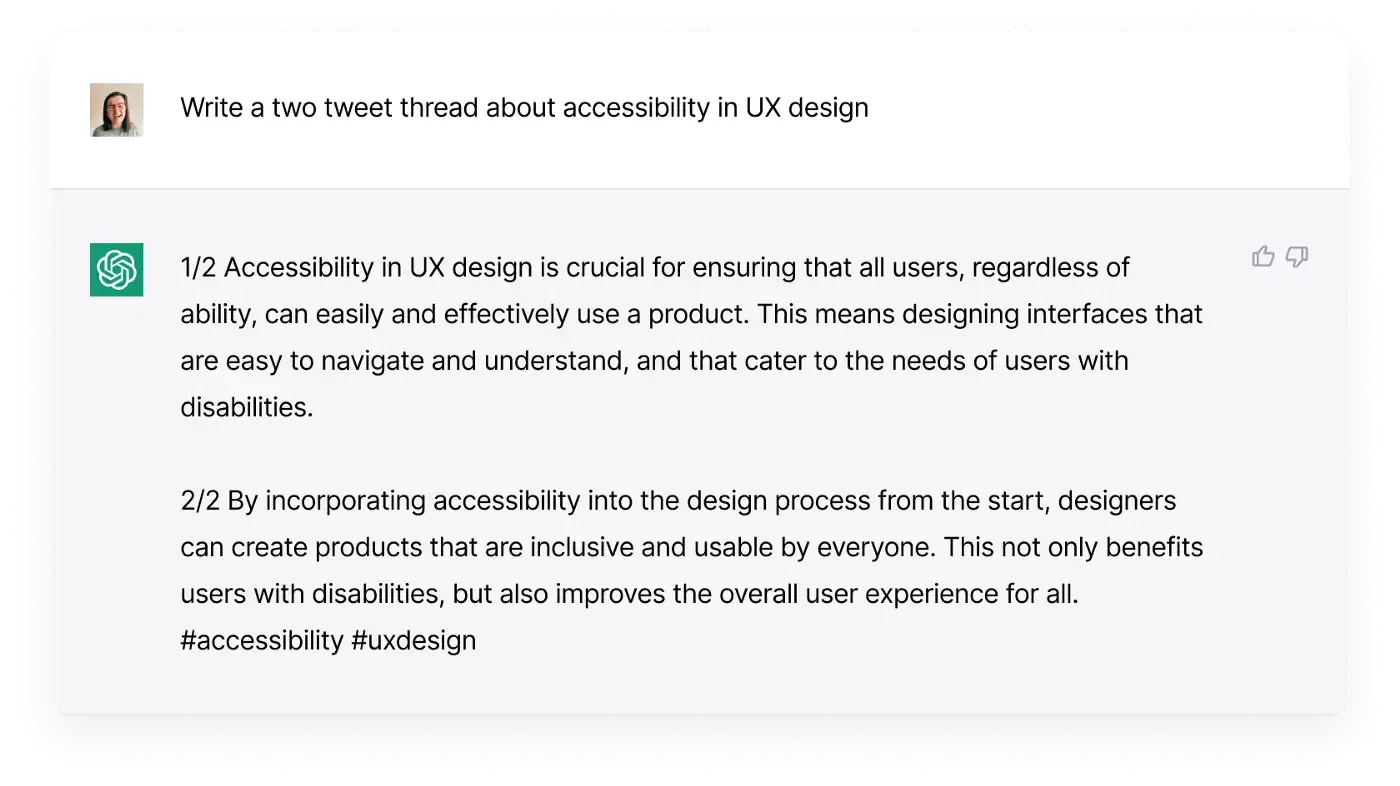
Out of all the posts, this was the only one that people called me out on. Within an hour of posting, Jess sent me this screenshot where she commented “Thank you, ChatGPT” although she didn’t post it.
My two housemates also mentioned to me that the post had “AI all over it”. Interestingly those three people were all in the room when I was introduced to Chat GPT and was experimenting with it.
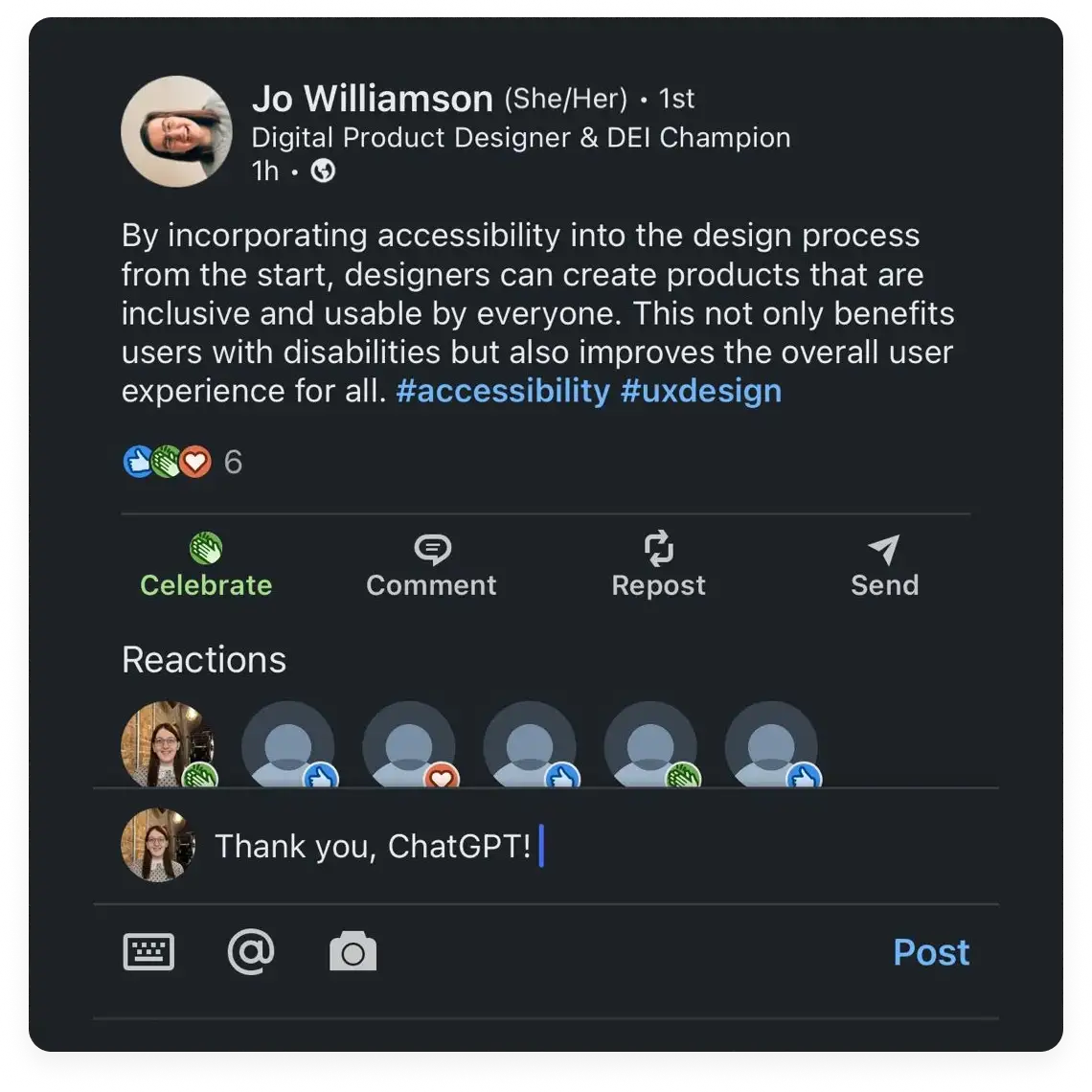
Overall it seemed the language and tone stood out to my LinkedIn audience. For my next post, I needed to give a more detailed prompt.
By this point, I had learned providing context and direction to the program leads to better results. A prompt that said “write a LinkedIn post” would create longer-form content that wasn’t right for me. Using Twitter’s character limit generated posts that were a length I preferred. In addition, providing the context of who was writing it — a young professional 💅 — and the tone I was aiming for “casual and fun but not too much” led to a better result.
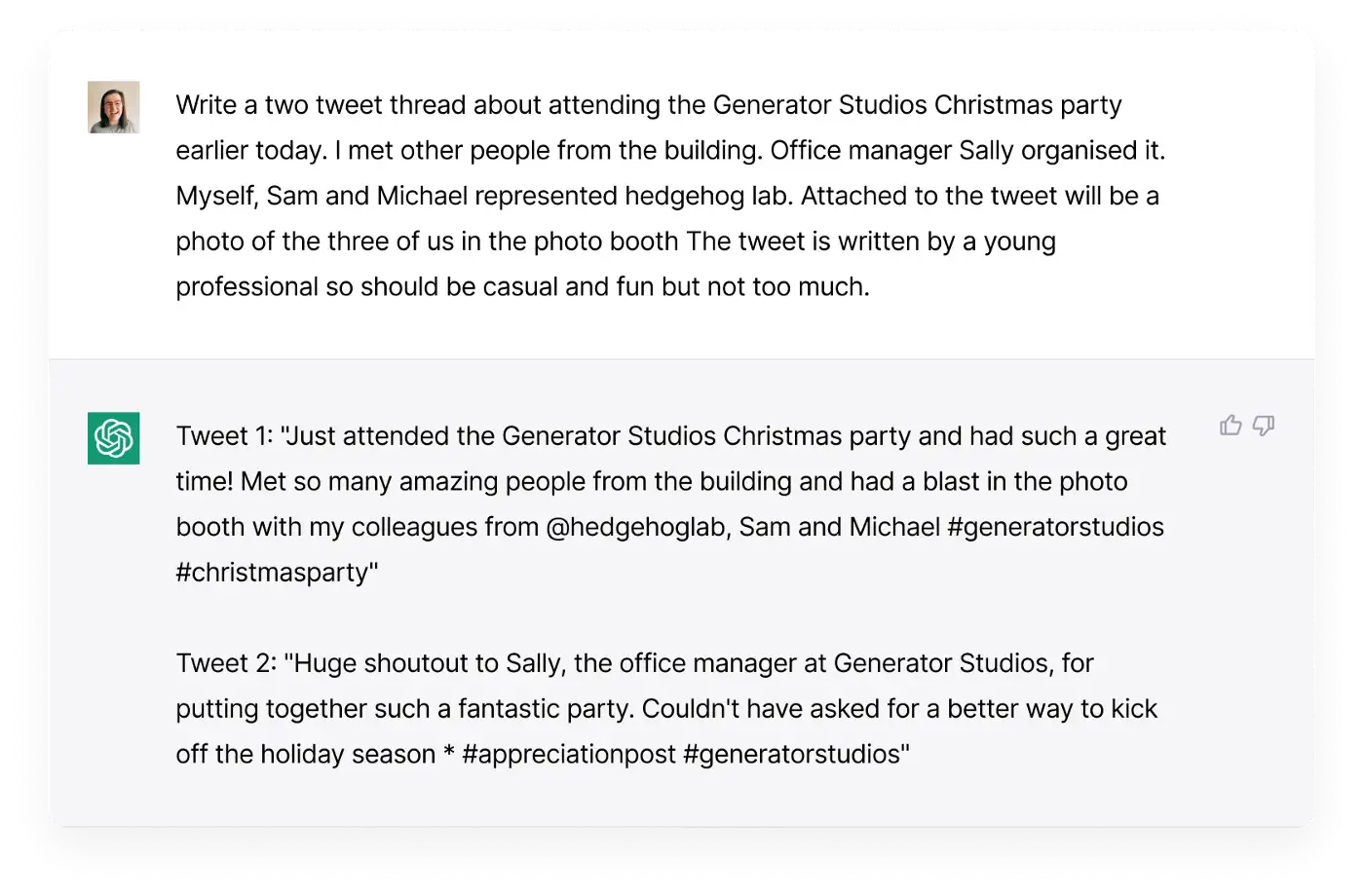
Let’s take that for a second though. “not too much” is amazingly non-specific, completely intangible and unquantifiable. But ChatGPT was able to interpret it and generate appropriate content that fit the desired tone. This highlights the power of its natural language processing and the ability of ChatGPT to understand and respond to more complex prompts.
In terms of analytics this post, had 1,052 impressions and 34 reactions. It’s important to remember that posts with pictures and tags generally get a larger reach.
I did enjoy that this post got a shout-out from hedgehog lab’s marketing executive — Antonia — in her monthly socials update. This post seemed to hit the mark on tone and language in a way the previous post didn’t.
This one got a bit meta: I used Chat GPT to write about Chat GPT. It took a bit longer to get the tone and language right. “Write a short LinkedIn post about how Chat GPT helps me write communications as someone with dyslexia”.
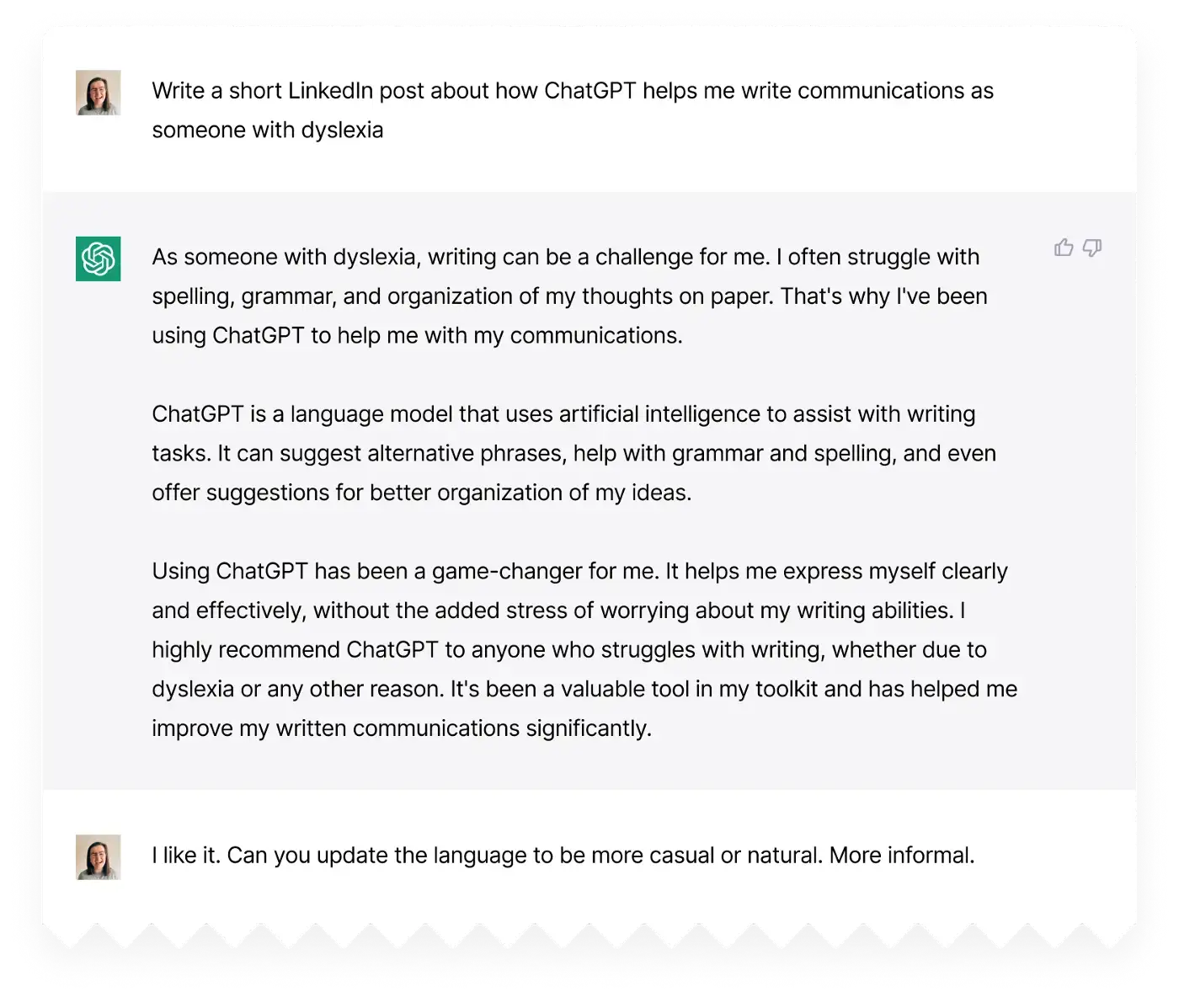 GPT nailed the content the first time. However, it needed some finessing in terms of tone and length. As you can see in the above screenshot, I asked it to make the language more informal and later to make it shorter.
GPT nailed the content the first time. However, it needed some finessing in terms of tone and length. As you can see in the above screenshot, I asked it to make the language more informal and later to make it shorter.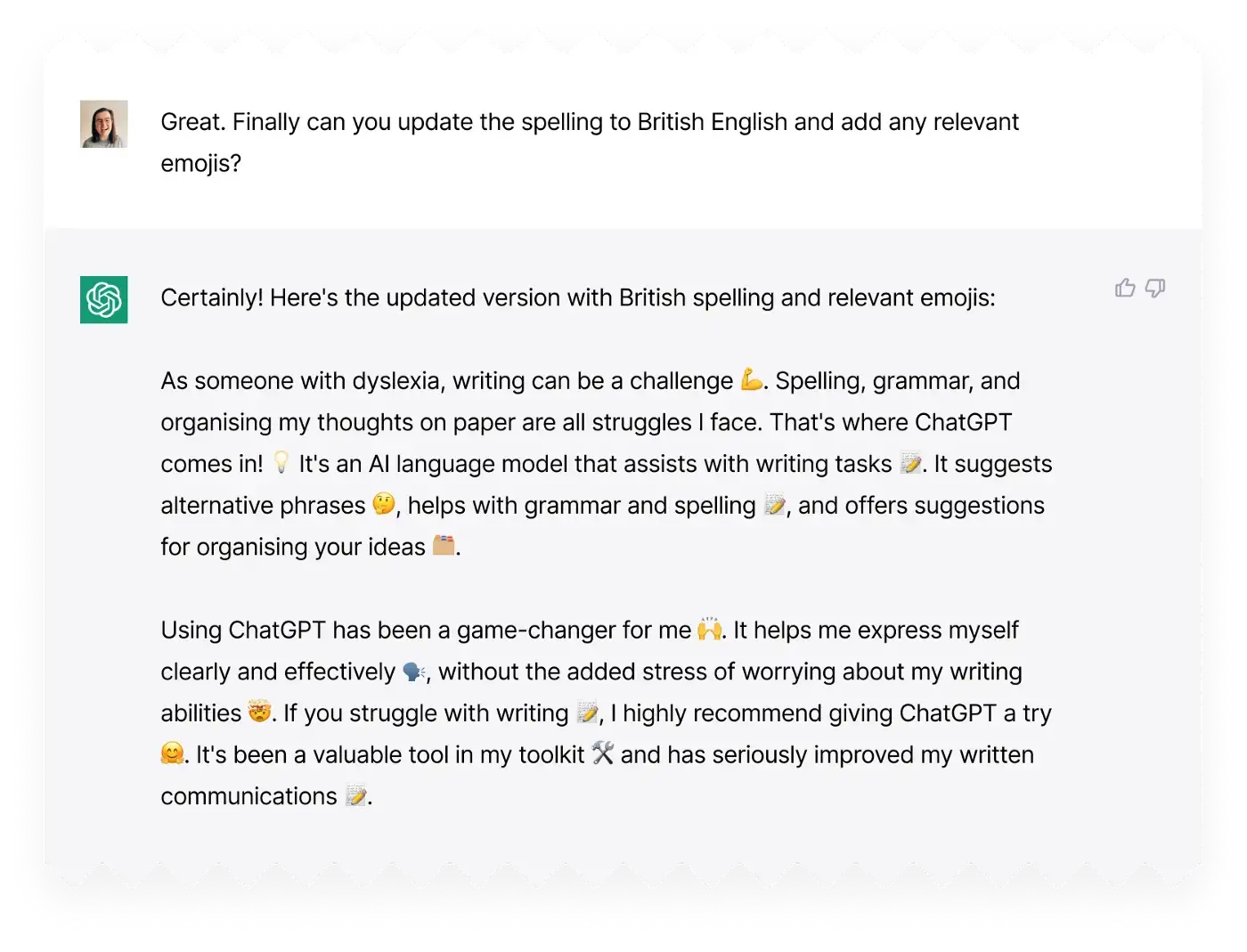
After tweaking the length, GPT got the tone spot on with the prompt with the “casual or natural”. In the case of the emojis, things got a bit out of hand (perhaps Chat GPT was trained by a boomer). With a bit more adjusting, we achieved the desired post. It even suggested relevant hashtags like #AI, #writingskills, #dyslexia, #communication, #languageprocessing, #productivity and #toolkit.
At the time of writing, this post had been up for 9 hours. It had 393 impressions and 11 reactions. Like the previous post, this one seemed to go unnoticed. No one has called it out… yet.
To compare the data, I looked at the three posts generated by Chat GPT and three of my most recent posts. Neither set of posts had massive engagement. The total impressions of Chat GPT posts was 2366, total impressions of my posts was 3146. Even though the two sets aren’t directly comparable, a general comparison is interesting.
So, in general, my posts had more total impressions and reactions than those written by GPT. Both sets had similar numbers of viewers from software engineers and user experience designers. My posts had more views from recruitment consultants, product designers, account managers, and UI designers, while Chat GPT had more views from product managers, founders, and project managers. Really, this isn’t unsurprising since they were both published to the same audience but the slightly higher reach of posts I’d written is at least noticeable.
This was a silly experiment with Chat GPT. While only one post was “rumbled,” the analytics weren’t significantly different between posts written by myself and those written by AI.
Did my experiment answer the questions I’d initially set out?
Would people notice? Initially yes. With vague and non specific prompts, the post was called out. With more detailed inputs and iterations from the initial output it seemed to go under the radar.
Would it simplify posting? Yes and no (helpful). In terms of time, it took me longer to generate the content I wanted to post. But (and I have no data to back this) the clarity of my posts felt better.
Would I get better analytics? Not noticeably. Compared to the last three posts I’d written, Chat GPT got 780 fewer impressions.
Ultimately, and unsurprisingly, the better and more detailed the prompt, the more accurate and appropriate output from GPT. But even with a well-crafted prompt, it won’t get it perfect. I’m no expert, but with AI in its current form, it’s a great assistant as long as a real person is validating and editing the output. Talking as someone with dyslexia, it is a game changer.
What I’m more interested in now is the relationship between AI like this and it’s users. If you noticed in this blog, I referenced “we”.
“With a bit more tweaking, we achieved the desired post”.
That’s collaborative.
How strange that after only a month of using Chat GPT, I had gotten to a point where it felt like I was working together with it. Similarly, I refer to my Google Home as “she” (mostly in the context of “she’s ignoring me”). As AI get more advanced they’re going to become more personalised and integrated into our everyday lives. After all, to write this post Chat GPT helped me outline the post, rephrase sentences etc. Notion AI helped me simplify some of the paragraphs and Grammarly made sure it was easy to read. Dall•e 2 created the thumbnail for this blog post. AI isn’t going anywhere fast.
I’m going back to posting by myself… okay maybe a little bit of help from GPT 🤷